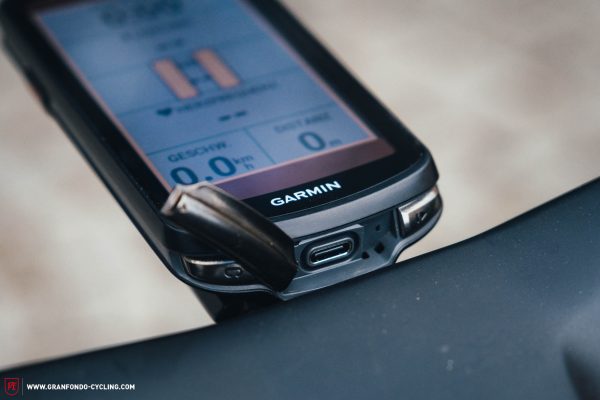Garmin Edge 1040 Solar bike computer in review
With a near endless battery life and smart features, the Garmin Edge 1040 Solar is set to become the ultimate training partner for ambitious riders. To trump the competition, Garmin have equipped their new flagship model with solar cells. We put the device to the test to find out what it’s capable of.

The Garmin Edge 1040 Solar is the new spearhead of Garmin’s bike computer range. In addition to a whole flood of new or refined training, navigation and safety features, the biggest innovation is the integrated solar cells. By harnessing the power of the sun, they promise to give you the kind of battery life you could only dream of until now. We made use of the summer sunshine to find out how well it works.

The Garmin Edge 1040 Solar in detail
The range of features of the new Garmin Edge 1040 Solar bike computer is so vast that listing them all here would go beyond the scope of this review. As such, we decided to stick to a summary of the most important ones. These can be roughly divided into two categories: performance analysis and guidance, and navigation. In terms of performance, the stamina insights of the Garmin Edge 1040 Solar show how much energy you have left so that you can pace yourself accordingly and thereby avoid premature exhaustion. The cycling ability and course demands functions can be used to view your own performance and compare it with the demands of a specific route. That way you can see if you’re prepared for what’s to come. The power guide can be used to create an effort strategy for a specific route. Along with that, you’ll also find the performance functions that were introduced on previous Edge devices, such as training load and status.

The type-specific maps that the Garmin Edge 1040 Solar displays often led us to gravel roads even though we were riding a road bike. There’s still work to be done here, Garmin!

The Garmin Edge 1040 Solar has such an abundance of features that it’s unlikely you’ll use all of them. Even ambitious athletes will find every function they need, especially in performance analysis and guidance.
For training guidance, the Edge 1040 Solar provides daily training suggestions and allows you to import your own training plans. The device’s navigation functions have been improved too. Thanks to improved maps, popular, type-specific routes are highlighted even if you haven’t got any navigation running, and you can search special points of interest and route to them. However, the most notable feature of the Garmin Edge 1040 Solar is its integrated solar cells, which are said to extend the battery life by up to 42 minutes per hour. This should give you a total battery life of 45 hours during heavy use, including all sensors and navigation. In battery saver mode, during which the display remains on, Garmin claim that the battery life extends to a whopping 100 hours. We tested these claims in real life conditions to see how it fared.

Testing the battery life of the Garmin Edge 1040 Solar
There’s no two ways about it, the battery life of the Garmin Edge 1040 Solar is incredible. It works so long that you’d be forgiven for forgetting that you must charge it at all in the summer. In fact, if you position your device strategically during breaks or between rides, you can occasionally get away with not charging it. But what does this look like in numbers? Unfortunately, there’s no easy answer to this question as every ride is different: the angle and intensity of the sunlight isn’t always the same, sometimes you’ll use the navigation function and sometimes you won’t. The lighting conditions can change, too, requiring you to increase the brightness of the backlight. As such, it’s impossible to give you a universal figure for how long the battery lasts.

…the Garmin Edge 1040 Solar can be plugged in via a USB-C cable. The cover of the charging socket is robust, looks classy and flows nicely into the two adjacent buttons.

The touchscreen of the Garmin Edge 1040 Solar proved to be very responsive – even in wet conditions. It’s easy to read in all conditions too.
That’s not to say we can’t give you a few examples, though. On various post-work rides with an average length of 2:30 hours, in dim sunlight, using all sensors except the navigation, the Edge 1040 Solar consumed between 5 and 6% percent of its battery capacity, which translates to roughly between 42 and 50 hours of battery life from a full charge. In full sunlight, the battery life would extend accordingly, while using navigation would shorten it. So, the manufacturer’s specifications of 45 hour battery life during heavy use seems completely realistic. As another example: during an 8:45 hour ride and a measured solar intensity of 48%, we achieved a battery use of 2:18 hours. In that case, increasing the solar intensity to 100% would get you about 4:48 hours of battery use, which would correspond to about 33 minutes of additional battery life per hour. That’s not quite as good as the maximum of 42 extra minutes per hour as indicated by Garmin. However, you’ve also got to take any of the device’s rounding errors into account when making these calculations. In addition, the battery use may not correlate to the sun’s intensity in a linear fashion. Either way, the device consumed just 16% of the battery capacity during this 8:45 hour tour – while using the navigation function and all sensors – which gives you a total battery life of over 54 hours or two days. And that’s pretty cool.

Unlike previous Edge devices, the mount for the Edge 1040 Solar is made of metal. As a result, it suffers from significantly less wear and tear and ensures that the computer will always stay securely put.
Our conclusion on the Garmin Edge 1040 Solar
The battery life of the Garmin Edge 1040 Solar is unbeatable, making it the ultimate companion for anyone who needs a GPS device that can go the long-haul – like at ultra-gravel events – or if you’re simply too lazy to charge the device. Of course, those who want to know everything about their performance and their efficiency will also get their money’s worth. However, if you’re on a tight budget and never cycle for more than two hours, you can confidently opt for a more affordable model.
Tops
- incredible battery life
- responsive touchscreen
- a myriad of functions for performance analysis and guidance
- classy design and high-quality look and feel
Flops
- suggested routes sometimes include paths that don’t suit the bike you’re riding
Tester Tobi
Duration 3 months
Price € 749.99
Weight 134 g
Intended use road/gravel
For more information about the Garmin Edge 1040 Solar, visit garmin.com.
Did you enjoy this article? If so, we would be stoked if you decide to support us with a monthly contribution. By becoming a supporter of GRAN FONDO, you will help secure a sustainable future for high-quality cycling journalism. Click here to learn more.
Words: Photos: Mike Hunger






